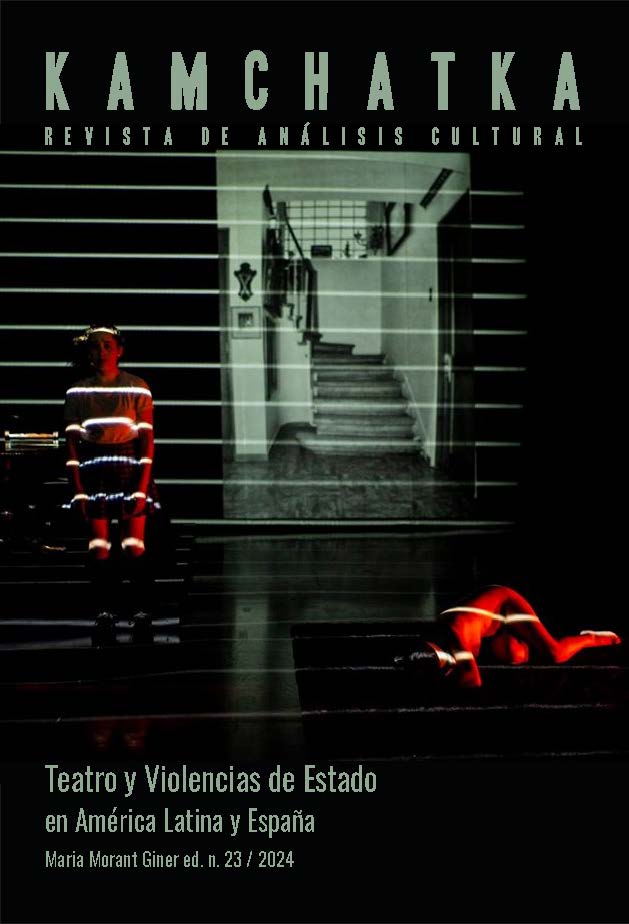Deadly girls in Latin American and Spanish poetry of the 1990s and 2000s
DOI:
https://doi.org/10.7203/KAM.23.26275Keywords:
Contemporary poetry, Infantility, “Cute” studies, Gender studies Abstract
Abstract
In this paper I study a genealogy of female poets whose lyrical subjects show traits of childishness, femininity and thanatic drives. First of all, I examine the poetry of several contemporary authors who, instead of creating poetic voices whose energy is “deadly”, generate characters whose mood tends to be optimistic. Secondly, I focus on the poetry of several authors whose lyrical subjects construct themselves as “dark little girls”, Latin American as well as Spanish. I do so by building a dialogue between some key poets of the 20th century (Marosa di Giorgio, Alejandra Pizarnik, Blanca Andreu and Pilar Pallarés) and poets of the 21st (María Castrejón, Begoña Callejón, Elena Medel, Alejandra del Río and Tilsa Otta). I
analyze in what way the nature of their “psychological darkness” is twofold, and to that end I rely on the philosophical and aesthetical category of “cuteness” (Sianne Ngai). Methodology-wise, I combine a strategy of close-reading that bonds the coincidences in the choice of tropes with a political interpretation that, using the concept of “cuteness”, dissects the the internal contradictions that affect the stereotypes against girls and “childish” women. These stereotypes are something that these poetic writings both reproduce and subvert.
 Downloads
Downloads
 References
References
Amícola, José. “Las nenas terribles de Silvina Ocampo y Marosa di Giorgio”. Cuadernos LIRICO
11 (2014).
Andreu, Blanca (1994). El sueño oscuro. Poesía reunida 1980-1989. Madrid: Hiperión.
Araújo, Helena. “Ejemplos De La ‘Niña Impura’ En Silvina Ocampo y Albalucía Ángel.” Hispamérica, vol. 13, 38 (1984): 27–35.
Buenaventura, Ramón, ed. (1985), Las diosas blancas: Antología de la poesía joven española escrita por mujeres, Madrid, Hiperión.
Callejón, Begoña (2010). Cenicienta en sangre. Almería: El Gaviero.
Castrejón, María (2015). Niñas. Madrid: Huerga & Fierro.
Del Río, Alejandra. “¡Hay una niña en un pozo!”. Creación, selección online.
Di Giorgio, Marosa (2017). La flor de lis. Madrid: Akal.
García Lorca, Federico (2012). Poesía completa. New York: Vintage español.
Iannamico, Roberta (2015). Qué lindo. Buenos Aires: Zindo & Gafuri.
Laguna, Fernanda (2012). Control o no control: poemas 1999-2011. Buenos Aires: Mansalva.
Laguna, Fernanda (2018). La princesa de mis sueños. Poesía 1994-2003. Rosario: Iván Rosado.
López-Luaces, Marta (2001). Ese extraño territorio: La representación de la infancia en tres escritoras latinoamericanas. Santiago de Chile: Editorial Cuarto Propio.
Medel, Elena (2002). Mi primer bikini. Barcelona: DVD.
Muschietti, Delfina (1995). “Alejandra Pizarnik y después: de la niña asesinada al punto de fuga.”
Spiller, Roland (ed.) Culturas del Río de la Plata (1973-1995). Frankfurt a. M., Madrid: Vervuert Verlagsgesellschaft: 217-228.
Ngai, Sianne (2015). Our Aesthetic Categories. Zany, Cute, Interesting. Cambridge: Harvard University Press.
Nietzsche, Friedrich. Así habló Zaratustra. Educar, publicación online del Gobierno de Argentina.
Ollé, Carmen (2014). Noches de adrenalina. Lima: Peisa.
Otta, Tilsa (2004). Mi niña veneno en el jardín de las baladas del recuerdo. Lima: Álbum del Uni-
verso Bakterial.
Pallarés, Pilar (2015). “Maña acordarei . . . ”. Reyes, Miriam (ed. y trad.) Punto de ebullición. Antología de la poesía contemporánea en gallego. Madrid: Fondo de Cultura Económica.
Patten, Ann Lucille (2008). ‘The female uncanny? : A historicised reading of the uncanny fiction of Edith Wharton, Shirley Jackson & Joyce Carol Oates. Dublin: Trinity College, School of English.
Pizarnik, Alejandra (2000). Poesía completa. Barcelona: Lumen.
Yuszczuk, Marina. “Como una fiesta en un libro para niños: muñecas subversivas en la poesía argentina, de Alejandra Pizarnik a las poetas mujeres de la década del noventa”. Cuadernos del Sur, Letras 42 (2012).
Downloads
Published
How to Cite
-
Abstract206
-
Artículo PDF (Español)146
Issue
Section
License
Copyright (c) 2024 Berta Garcia Faet

This work is licensed under a Creative Commons Attribution-NonCommercial 4.0 International License.
This journal provides an immediate free access to the content on the principle that freely make investigation available to the public, which promotes an increased global knowledge exchange.
Unless otherwise indicated, texts published in this journal are under the license Attribution-NonComercial 4.0 by Creative Commons. These texts may be copied, distributed and publicly communicated whenever the publication’s author and title are quoted and whenever they are not used for commercial purposes. In any case, intellectual property of the articles and its potential economic rights entirely belong to its authors.
The full license can be consulted on https://creativecommons.org/licenses/by-nc/4.0/. We encourage authors to disseminate papers published in Kamchatka. Journal of cultural analysis electronically, in institutional digital repository or in their websites.





